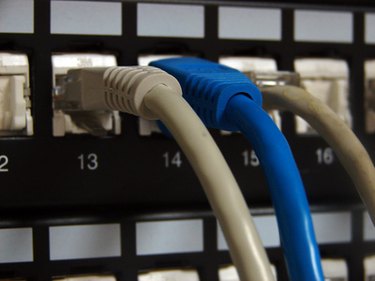
In computer networking, the term "client server" describes a network architecture where computers known as servers are used to centrally manage access to the network and to network resources and store data. Most business networks use client server architecture, as the advantages of client server implementations outweigh the disadvantages.
Centralized Server Advantage
Video of the Day
Having a single server hosting the database of user names and passwords and, at the same time, managing what levels of access individual users and computers can have to specific network resources is a distinct advantage of client server architecture. Fewer support staff are needed to manage centralized security accounts than would be needed if security and resource access had to be configured on each individual computer on the network. This advantage is even greater in networks where users typically access resources from a number of computers, as resource access and log-on permissions would have to be configured for each user, on each computer that they use.
Video of the Day
Centralized Server Disadvantage
Wherever a single server is used to manage resources on a network, there is always the chance that a failure of the server will bring network business to a halt. For example, if a single server hosts the user names and passwords database for a network, and the server suffers a failure, no users will be able to log on to the network until the server is fixed or replaced. A network where log-on information is configured and held on each computer does not have this problem, as the failure of a single computer does not prevent users of other computers from logging on and accessing network resources. Only the failed computer is affected.
Scalability Advantage
You can add resources in the form of network segments, computers and servers to a client server network without major interruptions to the network. Access to any new resources can be administered from the centralized security database, stored on a single network server. Without centralized servers hosting new resources, any new computers added to the network would need to be individually configured with the user names and passwords of all users who might potentially need to use them, and access to resources held on multiple computers would need to be configured on each computer hosting resources, for each user needing access to them. The larger the network becomes, the more IT support staff are needed simply to manage user accounts and resource access permissions. With a centralized server, permissions to all network resources can be granted by a smaller number of support staff configuring those permissions on the server.
Cost
In one sense, cost can be seen as an advantage of client server network architecture. Few support staff are required to maintain the network and maintain access to network resources. However, the cost of server hardware and software is greater than the cost of buying desktop hardware and software licences, and the fact that single dedicated servers pose a risk to the entire network should they fail means that most business employ expensive fail-safe systems, such as maintaining backup servers, ready to come on-line the moment that the primary server fails. This kind of duplication of resources and the expertise needed to manage and maintain it goes someway to offsetting the savings enjoyed by needing fewer desktop support staff.